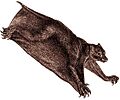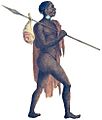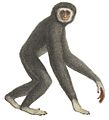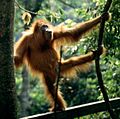Primate facts for kids
Quick facts for kids Primates |
|
|---|---|
 |
|
| Some primate families, from top to bottom: Daubentoniidae, Tarsiidae, Lemuridae, Lorisidae, Cebidae, Callitrichidae, Atelidae, Cercopithecidae, Hylobatidae, Hominidae | |
| Scientific classification | |
| Suborders, Infraorders, Parvorders, Superfamilies, and Families (16) | |
|
|
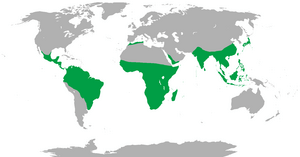 |
|
| Range of the nonhuman primates (green) |
A primate is a type of mammal that belongs to the animal group called Primates. These amazing creatures first appeared about 55 to 85 million years ago. They evolved from small mammals that lived on the ground. Over time, they adapted to living in tropical forests and climbing trees.
Many features of primates help them live in trees. They have large brains, excellent eyesight, and can see in color. Their shoulders are built for climbing, and their hands are very skillful. Primates come in many sizes. The smallest is Berthe's mouse lemur, which weighs only 30 grams (about 1 ounce). The largest is the eastern gorilla, which can weigh over 200 kilograms (440 pounds). Scientists have discovered between 190 and 448 different species of living primates. New species are still being found!
Primates are split into two main groups. The first group is the strepsirrhines, also known as "wet-nosed" primates. This group includes lemurs, galagos, and lorises. The second group is the haplorhines, or "dry-nosed" primates. This group includes tarsiers, monkeys, and apes, which also includes humans.
Monkeys and apes are also called simians. This group includes the "Old World monkeys" and apes, like baboons, macaques, gibbons, and great apes. It also includes the "New World monkeys," such as capuchins, howlers, and squirrel monkeys. About 60 million years ago, the simians split into these two main groups. Later, about 40 million years ago, some simians from Africa traveled to South America, probably by floating on natural rafts. This is how New World monkeys came to be.
Contents
Amazing Primate Features
Primates have bigger brains compared to other mammals of similar size. They rely a lot on their eyesight, while their sense of smell is not as strong as in many other mammals. Monkeys and apes have even better eyesight and larger brains than lemurs and lorises.
Many primates can see three main colors, just like humans. Most primates, except for apes, have tails. Many also have thumbs that can touch their other fingers, which helps them grasp things.
Primates often show differences between males and females. These differences can include muscle size, how fat is stored, the width of their hips, the size of their canine teeth, how their hair grows, and their color.
Primates grow up more slowly than other mammals of their size. They become adults later and live longer lives. Depending on the species, adult primates might live alone, in pairs, or in large groups with hundreds of members.
Some primates, like gorillas, humans, and baboons, spend most of their time on the ground. However, all primates can climb trees. They use different ways to move around in trees, like leaping from branch to branch or swinging (this is called brachiation). On the ground, some primates walk on two legs (bipedalism), while others walk on all four limbs, sometimes by knuckle-walking.
Primate Social Life
Primates are very social animals. They form different types of groups, such as pairs, family groups, groups with one male and many females, or groups with many males and many females. Most primate species still live at least partly in trees. The main exceptions are some great apes, baboons, and humans, who have moved from trees to live on the ground. Humans now live on every continent!
Protecting Primates
When humans and non-human primates live close together, there's a chance for diseases to spread between them. These are called zoonotic diseases, and they can include viruses like herpes, measles, Ebola, rabies, and hepatitis.
Thousands of non-human primates are used in scientific research around the world. This is because they are similar to humans in many ways, both physically and mentally.
Sadly, about 60% of primate species are in danger of extinction. The biggest threats to primates are deforestation (cutting down forests), forests being broken up into smaller pieces, and hunting. Primates are hunted for medicine, to be sold as pets, or for food. Clearing large areas of tropical forests for farming is the biggest danger to primates today.
Classification of Living Primates
Here is one way scientists classify the different families of living primates. There are other ways to classify them too!
- Order Primates
- Suborder Strepsirrhini: These are the lemurs, galagos, and lorisids.
- Infraorder Lemuriformes
- Superfamily Lemuroidea
- Infraorder Lemuriformes
- Suborder Strepsirrhini: These are the lemurs, galagos, and lorisids.
* Family Cheirogaleidae: dwarf lemurs and mouse-lemurs (34 species) * Family Daubentoniidae: aye-aye (one species) * Family Lemuridae: ring-tailed lemur and its relatives (21 species) * Family Lepilemuridae: sportive lemurs (26 species) * Family Indriidae: woolly lemurs and their relatives (19 species)
-
-
-
- Superfamily Lorisoidea
-
-
* Family Lorisidae: lorisids (14 species) * Family Galagidae: galagos (19 species)
-
- Suborder Haplorhini: These are the tarsiers, monkeys, and apes.
- Infraorder Tarsiiformes
- Family Tarsiidae: tarsiers (11 species)
- Infraorder Simiiformes (also called Anthropoidea)
- Parvorder Platyrrhini: These are the New World monkeys.
- Infraorder Tarsiiformes
- Suborder Haplorhini: These are the tarsiers, monkeys, and apes.
* Family Callitrichidae: marmosets and tamarins (42 species) * Family Cebidae: capuchins and squirrel monkeys (14 species) * Family Aotidae: night or owl monkeys (11 species) * Family Pitheciidae: titis, sakis, and uakaris (43 species) * Family Atelidae: howler, spider, woolly spider, and woolly monkeys (29 species)
-
-
-
- Parvorder Catarrhini
-
-
* Superfamily Cercopithecoidea ** Family Cercopithecidae: Old World monkeys (138 species) * Superfamily Hominoidea ** Family Hylobatidae: gibbons or "lesser apes" (18 species) ** Family Hominidae: great apes, including humans (8 species)
The name "Primates" was first used by Carl Linnaeus in 1758. He included humans, other apes and monkeys, lemurs, and bats in this group.
Images for kids
-
Ring-tailed lemur, a strepsirrhine primate
-
A colugo, a relative of primates.
-
A chimpanzee.
-
A gorilla.
-
An orangutan.
-
A gibbon.
-
An Old World monkey.
-
A tarsier.
-
A lemur.
-
A loris.
-
A 1927 drawing of chimpanzees, a gibbon (top right) and two orangutans (center and bottom center). The chimpanzee in the upper left is brachiating; the orangutan at the bottom center is knuckle-walking.
-
Homo sapiens is the only living primate species that is fully bipedal.
-
Nilgiri langur (Trachypithecus johnii), an Old World monkey.
-
Common brown lemur, a Strepsirrhine primate
-
Diademed sifaka, a lemur that is a vertical clinger and leaper
-
The tapetum lucidum of a northern greater galago, typical of prosimians, reflects the light of the photographer's flash
-
A social huddle of ring-tailed lemurs. The two individuals on the right exposing their white ventral surface are sunning themselves.
-
A crab-eating macaque breastfeeding her baby
-
Leaf eating mantled guereza, a species of black-and-white colobus
-
Slow lorises are popular in the exotic pet trade, which threatens wild populations.
-
Sam, a rhesus macaque, was flown into space by NASA in 1959.
-
The critically endangered silky sifaka
-
The critically endangered Sumatran orangutan
See also
 In Spanish: Primates para niños
In Spanish: Primates para niños



